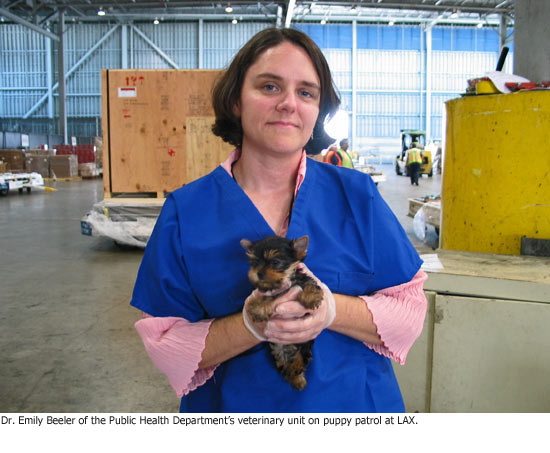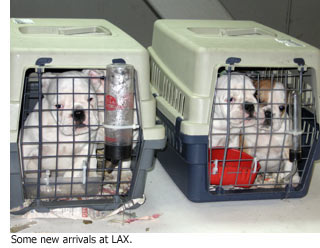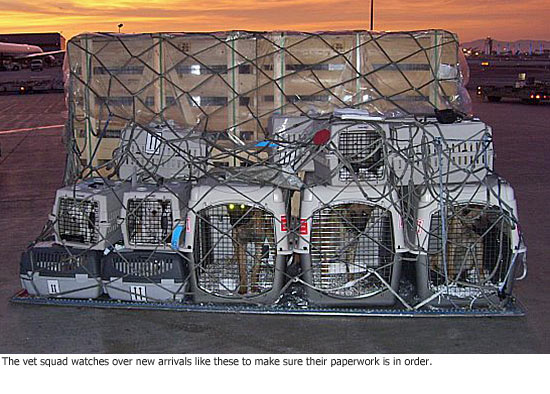Vet squad learning new tricks
February 9, 2011
 If it’s a jungle out there, Dr. Karen Ehnert and her staff are L.A. County’s safari guides.
If it’s a jungle out there, Dr. Karen Ehnert and her staff are L.A. County’s safari guides.
They know where the dogs are biting, where the rabid bats are hanging and where the raccoons have distemper.
They can tell when unscrupulous dog importers are bringing in underage puppies with bogus paperwork claiming vaccinations that never happened.
And, increasingly, they can see how the well-being of humans and animals is interrelated—for better or worse.
The multifaceted mission of the Department of Public Health’s little-known veterinary unit is testament to how times have changed for animals and humans alike in Los Angeles.
“Now that animals are becoming members of the family, sleeping in people’s beds, we need to create ways to help people improve their pets’ health, and improve their own health, too,” says Ehnert, 50, a UC Davis-trained veterinarian who’s been acting director of the unit since June. “There’s an incredible human-animal bond.” Walking and exercising family pets outdoors can also play a broader social role in the county, helping people “take back their communities,” she says. “There’s a huge public health benefit.”
The vet squad dates from a time when hoof-and-mouth outbreaks were bigger news than Hollywood gossip, and people thought of anthrax as a cattle disease, not a terrorist weapon.
A history of the department, written by Dr. Patrick Ryan, who retired last year, is full of fascinating and sometimes gruesome tidbits chronicling L.A.’s bygone livestock quarantines, tuberculosis-tainted dairy herds, disease-ridden slaughterhouses, garbage-swilling hogs and, during the Depression, roving rabid dogs attacking horses and cattle.
Well, L.A.’s no cow town anymore. And Ehnert and her unit are evolving to serve a metropolis in which people outnumber livestock, and canine rabies has long been wiped out, thanks to widespread vaccination programs. The last time a Los Angeles dog was reported to have had rabies was in 1962.
A primary mission of the team these days is still rabies control, but the culprits now are very different, with bats the likeliest to be infected, followed by skunks and foxes. This “Rabies Tales” comic, created by one of the department’s veterinarians, Dr. Emily Beeler, gives a good overview of how to handle exposure to a potentially rabid bat. (It also provides the welcome news that rabies shots are not given in the abdomen anymore.)
The unit takes reports on virtually every animal bite that comes to the attention of medical or law enforcement authorities in the county. It currently is working on a community-by-community analysis of where dog bites are most prevalent.
And it has an educational role, communicating with veterinarians in practice throughout the county and with the public at large about disease outbreaks and protective measures, including the importance of regular vaccinations to prevent many pet illnesses.
Lately, it’s been using the department’s Twitter feed to spread the word about how healthy human habits can lead to healthier pets. One recent Tweet focused on how smoking hurts pets.
It’s also preparing an online “Pet Health and Safety Quiz,” modeled on the department’s Food Safety Quiz (in which home cooks can test their food preparation savvy against the department’s standards for restaurant inspection and grading.)
What’s more, the vet squad has been a key player in a multi-jurisdictional effort called the “Border Puppy Task Force,” aimed at stopping the importation of sick and unvaccinated puppies through Los Angeles International Airport.
Ehnert said her team’s spot checks at the airport as part of that effort found that 40% of the large shipments of puppies coming through had falsified paperwork. The phony documents would claim, for instance, that the incoming dogs were four months old and had been vaccinated when in fact they were less than 8 weeks old—too young to have teeth, let alone effective vaccinations. In recent years, popular imported breeds coming through LAX have included English and French bulldog puppies from Colombia.
The vet squad currently is working on a proposal to turn its spot checks into a more regular monitoring arrangement, working in tandem with federal officials stationed at the airport.
The unit has undergone its share of changes over the years. Its lab was closed due to budget cuts in the mid-1990s. Its veterinary staff was shifted for a time to the Department of Animal Care & Control but later rejoined public health. Now budget cuts may once again affect the unit, which has 4 licensed vets and a registered veterinary technician among its 19 budgeted positions. Ehnert says seven of those slots are currently vacant due to retirements and leaves of absence.
The budget uncertainty hasn’t stopped the vet squad from looking ahead.
Ehnert is proposing a “2020 Healthy Pets, Healthy Families” initiative that would bring together veterinary educators, local vets, animal control agencies and public health officials with the goal of producing new standards for pet health by the year 2020. “Healthy pets can lead to healthy people,” Ehnert says in her proposal for the effort, intended as a pet-centric offshoot of the federal government’s Healthy People 2020 initiative.
“The idea is to create a model for the nation,” Ehnert says. “Nobody’s really talking about animal health and galvanizing the community.”
Posted 2/8/11












 405 bridge work causes a stink
405 bridge work causes a stink
